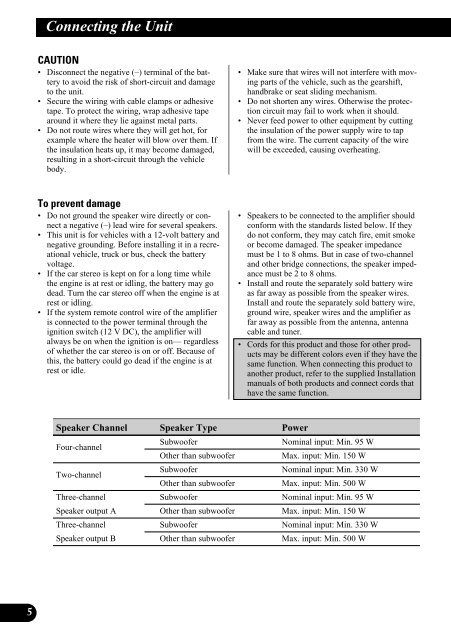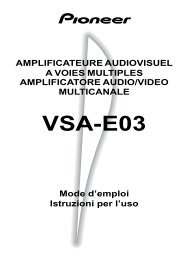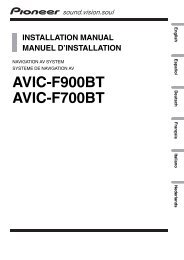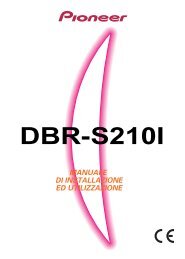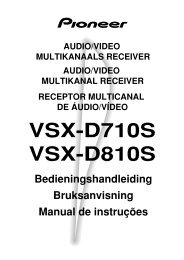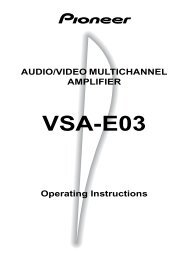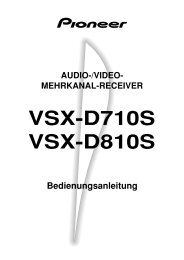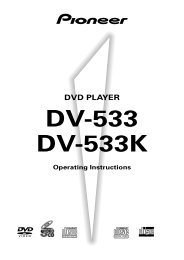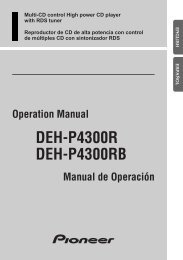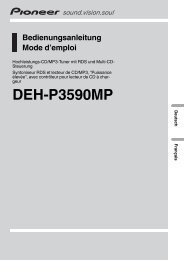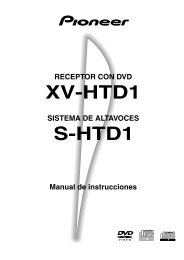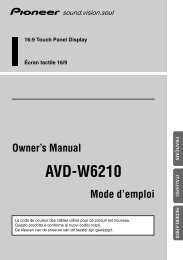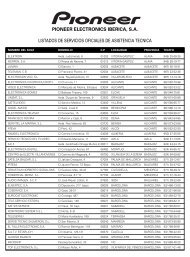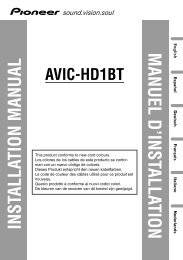GM-X944 - Service.pioneer-eur.com - Pioneer
GM-X944 - Service.pioneer-eur.com - Pioneer
GM-X944 - Service.pioneer-eur.com - Pioneer
You also want an ePaper? Increase the reach of your titles
YUMPU automatically turns print PDFs into web optimized ePapers that Google loves.
Connecting the Unit<br />
CAUTION<br />
• Disconnect the negative (–) terminal of the battery<br />
to avoid the risk of short-circuit and damage<br />
to the unit.<br />
• Secure the wiring with cable clamps or adhesive<br />
tape. To protect the wiring, wrap adhesive tape<br />
around it where they lie against metal parts.<br />
• Do not route wires where they will get hot, for<br />
example where the heater will blow over them. If<br />
the insulation heats up, it may be<strong>com</strong>e damaged,<br />
resulting in a short-circuit through the vehicle<br />
body.<br />
• Make sure that wires will not interfere with moving<br />
parts of the vehicle, such as the gearshift,<br />
handbrake or seat sliding mechanism.<br />
• Do not shorten any wires. Otherwise the protection<br />
circuit may fail to work when it should.<br />
• Never feed power to other equipment by cutting<br />
the insulation of the power supply wire to tap<br />
from the wire. The current capacity of the wire<br />
will be exceeded, causing overheating.<br />
To prevent damage<br />
• Do not ground the speaker wire directly or connect<br />
a negative (–) lead wire for several speakers.<br />
• This unit is for vehicles with a 12-volt battery and<br />
negative grounding. Before installing it in a recreational<br />
vehicle, truck or bus, check the battery<br />
voltage.<br />
• If the car stereo is kept on for a long time while<br />
the engine is at rest or idling, the battery may go<br />
dead. Turn the car stereo off when the engine is at<br />
rest or idling.<br />
• If the system remote control wire of the amplifier<br />
is connected to the power terminal through the<br />
ignition switch (12 V DC), the amplifier will<br />
always be on when the ignition is on— regardless<br />
of whether the car stereo is on or off. Because of<br />
this, the battery could go dead if the engine is at<br />
rest or idle.<br />
• Speakers to be connected to the amplifier should<br />
conform with the standards listed below. If they<br />
do not conform, they may catch fire, emit smoke<br />
or be<strong>com</strong>e damaged. The speaker impedance<br />
must be 1 to 8 ohms. But in case of two-channel<br />
and other bridge connections, the speaker impedance<br />
must be 2 to 8 ohms.<br />
• Install and route the separately sold battery wire<br />
as far away as possible from the speaker wires.<br />
Install and route the separately sold battery wire,<br />
ground wire, speaker wires and the amplifier as<br />
far away as possible from the antenna, antenna<br />
cable and tuner.<br />
• Cords for this product and those for other products<br />
may be different colors even if they have the<br />
same function. When connecting this product to<br />
another product, refer to the supplied Installation<br />
manuals of both products and connect cords that<br />
have the same function.<br />
Speaker Channel Speaker Type Power<br />
Four-channel<br />
Subwoofer<br />
Nominal input: Min. 95 W<br />
Other than subwoofer<br />
Max. input: Min. 150 W<br />
Two-channel<br />
Subwoofer<br />
Nominal input: Min. 330 W<br />
Other than subwoofer<br />
Max. input: Min. 500 W<br />
Three-channel Subwoofer Nominal input: Min. 95 W<br />
Speaker output A Other than subwoofer Max. input: Min. 150 W<br />
Three-channel Subwoofer Nominal input: Min. 330 W<br />
Speaker output B Other than subwoofer Max. input: Min. 500 W<br />
5


